April showers bring May flowers — and bugs. Avoid these Florida insects this summer
Spring and summer bring great weather, but they also bring a few pests. Heading to Pensacola Beach? Watch out for yellow flies. Mowing your yard? Watch for fire ants. Looking through your closet? Don't let the silverfish spook you.
Living in Florida means finding a way to live harmoniously with its myriad insects. Most only show themselves after you've stumbled upon them, but plenty of insects can ruin your day — even if it's just from the sight of them.
Here's a list of common Florida bugs you'll likely run into this summer and what you should (or shouldn't) do when you spot them.
Florida cicadas: 2024 cicadas map: Here's where to see trillions of insects. Want quiet? Avoid these states
Ants
Ants are everywhere, so Florida is certainly not special for having them. What’s important is identifying the type of ant so you can know what actions you may need to take.
Fire ants, for instance, are fairly common and can be a big pain after they set up a nest, typically in bright and open spaces. Odorous house ants, on the other hand, aren’t going to bite you or ruin your home, but they are known for entering homes in search of left-out food.
Here are some common ants you’ll find in Florida and what to be aware of.
Fire ants: You can tell fire ants are bad news by name alone. These small, red ants can cause serious pain when they bite, typically followed by a sting. The combination results in a burning sensation lasting for a few minutes. According to Florida Pest Control, some bites can leave you with hive-like pimples filled with yellow fluid. Large colonies can also damage your yard, plants and even electrical outlets. Mounds should be removed if found.
Carpenter ants: Carpenter ants aren’t likely to bite you, but they can pose a significant danger to your home. They are often mistaken for termites because they excavate their nests into wood. If you see tiny piles of sawdust or hear something rustling in your wall, then it might be a good idea to get an inspection.
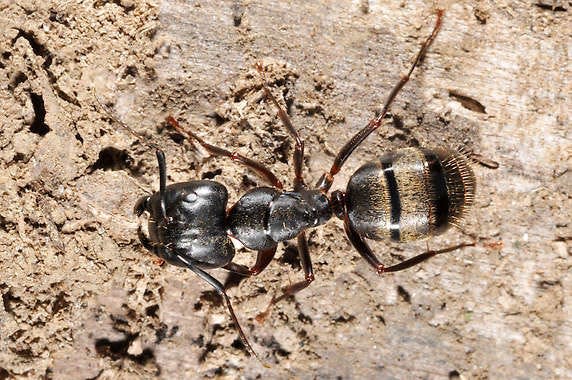
Big-headed ants: Keeping up with literal naming convention, big-headed ants can easily be identified by their disproportionately sized heads. These ants look scarier than they are. Big-headed ants generally don't bite unprovoked. They're considered nuisances as they can drum up dirt and sand into areas of your home they've foraged into. Because of their large colonies, these usually need to be removed by professional exterminators.
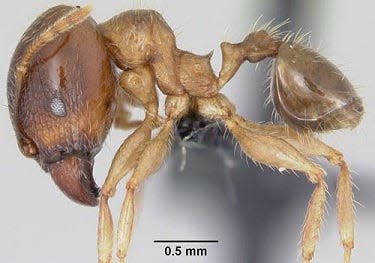
Here are some other ants to be weary of:
Argentine ant: These don't pose a serious threat, but they can rapidly form huge colonies if left untreated.
Harvester ant: Harvester ants are typically found outside. They are aggressive and they have an infamous sting better left read about than felt.
Pharaoh ant: Pharaoh ants don't bite, but they do carry and transmit dangerous pathogens to people and their pets, such as salmonella and streptococcus, according to Florida Pest Control.
Yellow fly
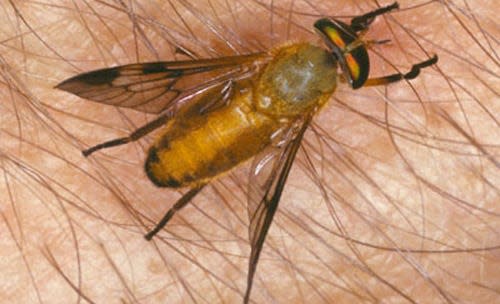
Florida has a lot of flies. While most of them are content annoying you with their presence, one group of flies isn’t afraid to go in for the bite — yellow flies.
The University of Florida says that “yellow fly” describes “about a dozen yellow-bodied biting flies in the Tabanidae family.” In Florida, the name is specifically used to describe the diachlorus ferrugatus species, also known as the doctor fly.
These yellow flies are like mosquitoes in that the female fly is responsible for biting. Yellow flies are common when it gets hot in summer and early fall weather. They are active during daylight hours.
Termites
Termites, like ants, probably don’t need any introduction. These tiny bugs, which look very similar to ants, can be a nightmare to deal with as a homeowner. In the U.S., termites are responsible for $5 billion in damages each year, according to Native Pest Management.
Subterranean and drywood termites are two of the most common species of termites, and getting rid of them is something that requires professional help. Treatment includes tent fumigation, setting up bait stations and termite trenching.
Love bugs
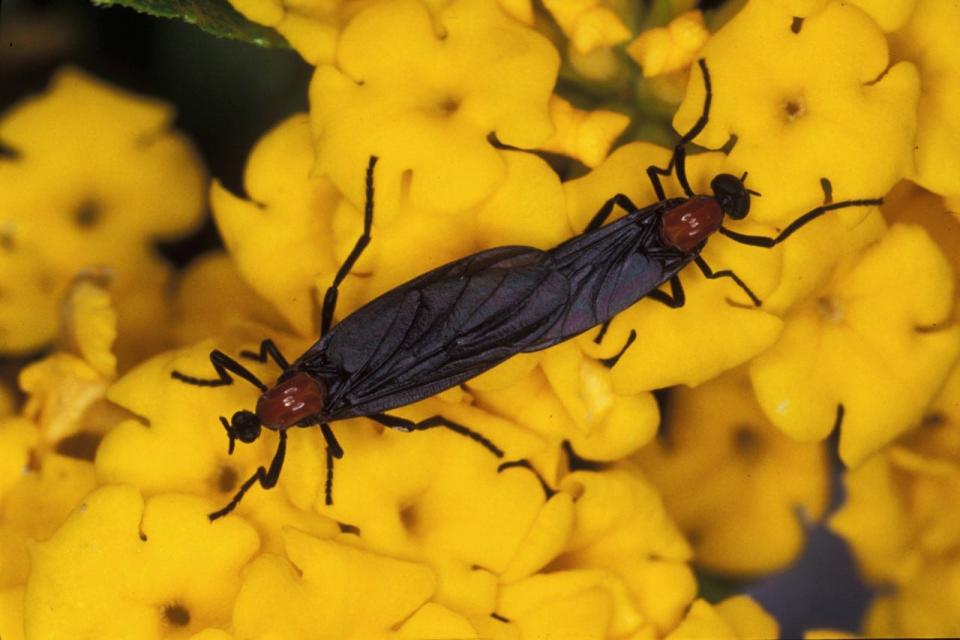
Love bugs aren’t really a nuisance in the same way as the aforementioned insects as they don’t bite or sting, and they aren’t likely to cause property damage, though scraping your bumper and windshield off after driving through some Florida backroads might convince you otherwise.
Love bugs are a species of march flies that are easy to identify during mating season as male and female bugs will remain attached, end to end, for several days after mating. Peak mating seasons tend to fall around May and September.
Fortunately, your home isn’t likely to become overrun with love bugs as they tend to be more attracted to roads and highways. Prevention is an easy way to get ahead of any possible infestation by simply keeping a clean environment. If you find your property inundated, you can try using light colored traps, insect spray or fans to deter them (they’re not great flyers) or you can even vacuum them up.
Palmetto bugs (cockroaches)
Palmetto bugs, water bugs, Florida wood cockroach, these are all different names for the same thing — the good ol’ American cockroach. You can find roaches pretty much anywhere, but they really enjoy hanging out inside humid areas like basements, sewers and crawl spaces.
Spotting the occasional wood cockroach may not be a cause for concern as they tend to move around as temperatures change. Frequent sighting may mean there is a bigger problem afoot.
In Florida, cockroaches are kind of like water, if there is a place for them to crawl into, you can bet they’ll find it. So naturally, one of the best ways to prevent them from getting inside your home is to walk around your home and note any cracks or crevices so you can later fill them in.
Keeping up with home chores can be a lot to handle, but leaving food out or standing water can attract roaches. So, it’s best to make sure you don’t leave dirty dishes in the sink and to make sure your spaces are relatively clean.
Given that roaches love to hide in humid spots, investing in a dehumidifier can help kick them to the curb.
Mosquitoes
Mosquitoes can be found anywhere, but Florida’s already uncomfortable heat and humidity are much worse when you realize you’re breathing the same air as the Centers for Disease Control and Prevention calls the “world’s deadliest animal.”
Malaria, dengue, West Nile, yellow fever and Zika are just a few of the deadly diseases these pests have spread, resulting in the death of millions of people across the globe. Despite being contained in most areas throughout the U.S., many of these diseases are still a factor here in Florida.
Preventing mosquitoes from swarming your yard requires much of the same maintenance and care as preventing most other bugs: removing standing water and keeping your yard clean. Native Pest Management says that mosquito dunks are another effective method.
Dunks are a biological product with a mosquito-larvae-killing bacteria that’s harmless to people and pets. These can be placed in pools of water that don’t need to be emptied or refreshed.
Silverfish
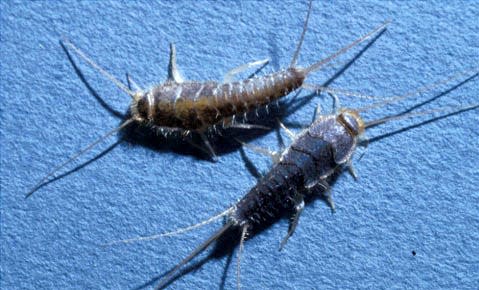
Silverfish are small insects that have a silver tint to them and move a bit like fish. You’ve probably run into them while reorganizing a messy closet or drawer. They’re nocturnal and mostly keep out of sight. They don’t cause any direct damage but can aggravate allergies.
You can get rid of or prevent silverfish in the same way you get rid of roaches. Keeping areas free of clutter will reduce the places they hide inside your home, and reducing the humidity inside your home can deter them. If you notice them around, sprinkling diatomaceous earth, which is pet friendly, can help get rid of them.
This article originally appeared on Pensacola News Journal: Do Florida bugs make your skin crawl? Here are the ones to watch

